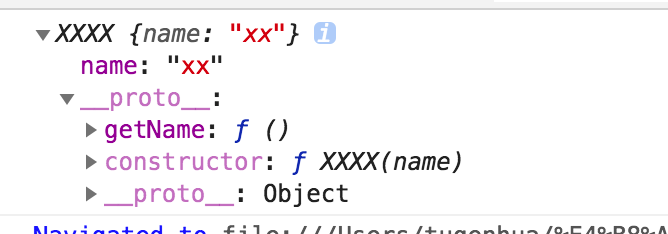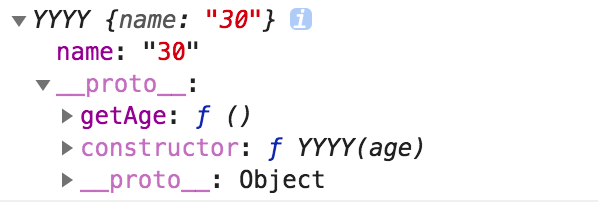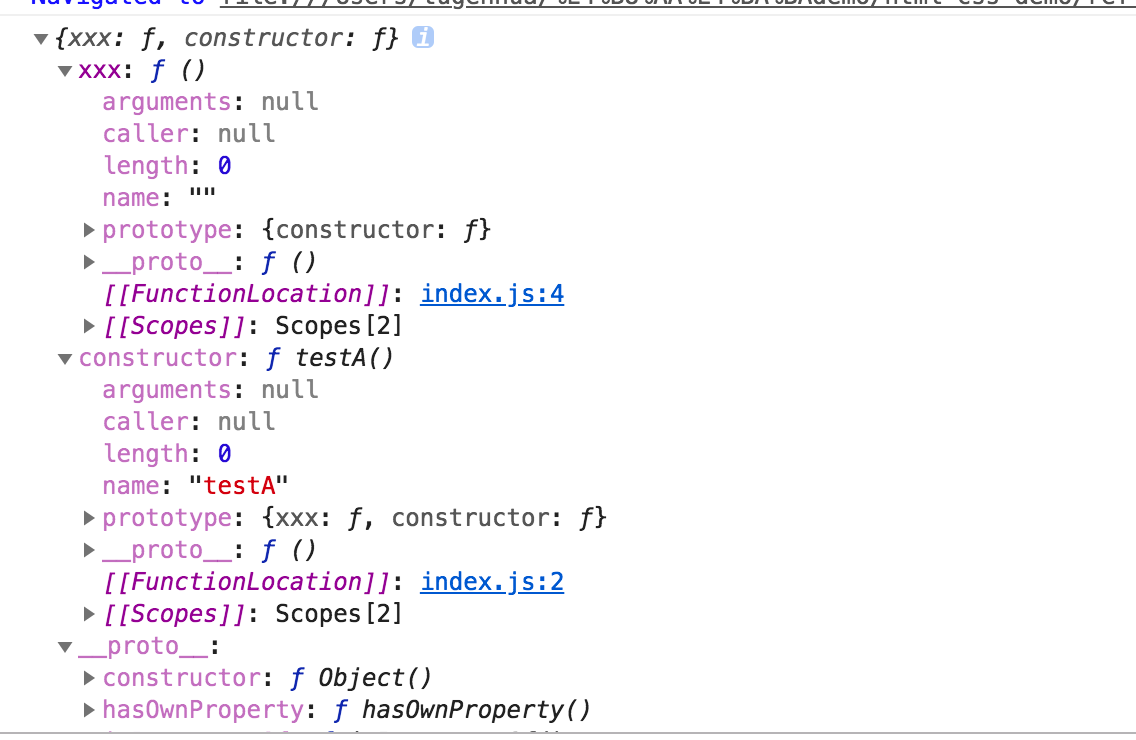每日一题: 细说es6中的Reflect
1、Reflect是什么,有什么作用?
Reflect是ES6为了操作对象而新增的API,Reflect对象是一个全局的普通的对象,Reflect的原型就是Object.
作用:将Object对象的一些明显属于语言内部的方法(比如Object.defineProperty),放到Reflect对象上,那么以后我们就可以从Reflect对象上可以拿到语言内部的方法。
2、实际例子
2.1 Reflect.get(target, name, receiver)
该方法是用来读取一个对象的属性。
参数如下解析:
target: 目标对象
name: 是我们要读取的属性。
receiver(可选): 可以理解为上下文this对象。
const obj2 = {
name: 'kongzhi2',
age: 30,
get xxx() {
console.log(this.name);
console.log('----xxxx---');
return 0;
}
};
console.log(Reflect.get(obj2, 'xxx', {name: 'happy2'}));
/*
先执行 obj2 该对象中的 xxx 方法,指定了第三个参数作为该上下文对象,
因此会打印 happy2, 然后继续打印 ----xxxx---, 最后我们可以看到
有返回值为0,因此打印0了
*/
2.2 Reflect.set(target,name,value,receiver)
上面的get方法是获取对象中的值,那么set就是设置该对象的属性值了,参数解析简单如下:
target: 我们需要操作的对象。
name: 我们需要设置该对象的属性名。
value: 我们要设置的属性值。
receiver: 可以理解为上下文this对象。如果我们在设置值的时候遇到setter函数,该参数就指向与setter中上下文this对象。
该函数会返回一个Boolean的值,代表在目标对象上设置属性是否成功。
const obj = {
age: 30,
set name(name) {
console.log(this);
console.log('-------');
}
};
const res = Reflect.set(obj, 'age', 31);
console.log(res); // true
console.log(obj); // {age: 31, set name:function} 这样的
console.log(obj.age); // 打印 31
/*
如下代码,设置 obj对象中的name属性,因此打印 console.log(this)
返回 {age: 31, set name:function} 这样的, console.log(res2)返回true,设置成功
*/
const res2 = Reflect.set(obj, 'name', 'xxxx');
console.log(res2); // true
/*
先执行 set 中的name方法,打印 console.log(this);this就指向了第四个参数 {test: 'test'}
然后会打印 '-----';
*/
const r2 = Reflect.set(obj, 'name', 'dreamapple', {test: 'test'}); // this: --> { test: 'test' }
console.log(r2); // true
console.log(obj); // { name: [Setter], age: 31 }
2.3 Reflect.apply(target,thisArg,args)
该方法的含义是:通过指定的参数列表对该目标函数的调用。该方法类似于我们之前的 Function.prototype.apply 方法的。
参数解析如下:
target: 我们的目标函数.
thisArg: target函数调用的时候绑定的this对象。
args: 就是函数参数列表。
// 查找数组里面最小的元素值
const arrs = [1, 2, 3, 4];
// ES6 的语法如下
const min = Reflect.apply(Math.min, arrs, arrs);
console.log(min); // 1
// ES5的语法如下:
const min2 = Math.min.apply(arrs, arrs);
console.log(min2); // 1
// 或者我们使用 Finction.prototype 代码如下演示
const min3 = Function.prototype.apply.call(Math.min, arrs, arrs);
console.log(min3); // 1
// 下面是截取字符串的方法演示下
const strs = 'kongzhi';
// 使用ES6的语法 代码演示如下:
const str1 = Reflect.apply(String.prototype.slice, strs, [0, 3]);
console.log(str1); // 打印 kon
// 使用 ES5的语法
const str2 = strs.slice(0, 3);
console.log(str2); // 打印 kon
// 或者我们使用 String.prototype 代码如下演示
const str3 = String.prototype.slice.apply(strs, [0, 3]);
console.log(str3); // kon
2.4 Reflect.construct(target,args[, newTarget])
该方法的作用和 new AAA() 创建一个实列方法作用类似,那么使用该方法,我们就可以提供一种不使用new来调用构造函数的方法,
参数含义如下:
target: 被运行的目标函数。
args: 调用构造函数传递的参数数组或伪数组。
newTarget: 也是构造函数,表示使用 Reflect.construct后生成的实列对象是谁的实列。如果没有该参数,默认生成的实列对象就和target构造函数是一样的。
function XXXX(name) {
this.name = name;
}
XXXX.prototype.getName = function() {
return this.name;
}
function YYYY(age) {
this.age = age;
}
YYYY.prototype.getAge = function() {
return this.age || 31;
}
// 使用 XXXX函数作为构造函数, 那么构造函数就指向了 XXXX函数
const xxxx = Reflect.construct(XXXX, ['xx']);
console.log(xxxx); // 打印 XXXX {name: xx}
console.log(xxxx.getName()); // 打印 xx
结果如下:

使用 YYYY 函数作为构造函数,那么构造函数就指向了 YYYY函数
const yyyy = Reflect.construct(XXXX, ['30'], YYYY);
console.log(yyyy); // 打印 YYYY {name: 30}
console.log(yyyy.name); // 30
console.log(yyyy.age); // undefined
console.log(yyyy instanceof YYYY); // true
console.log(yyyy instanceof XXXX); // false
console.log(yyyy.getAge()); // 31
如上demo所示:当const xxxx = Reflect.construct(XXXX, ['xx']); 没有第三个参数的时候,那么构造函数指向了 XXXX 函数。
我们继续看第二个demo,const yyyy = Reflect.construct(XXXX, ['30'], YYYY); 有第三个参数,因此 yyyy的实列指向了 YYYY.
如上代码打印的信息看到 console.log(yyyy instanceof YYYY); 返回true, console.log(yyyy instanceof XXXX); 返回false.
但是呢 console.log(yyyy.getAge()); 返回的是 31. 如果我们没有默认的 31值的话,那么就应该返回undefined了,可以看到,请看下面的注意总结:
注意:如果有第三个参数的话,那么我们的实列由两部分组成,实列的属性部分由第一部分构造函数生成。实列的方法由第三个参数对象生成。
比如上面打印的 console.log(yyyy); // 打印 YYYY {name: 30} 看到只返回了 XXXX中的name属性,XXXX中的getName方法并没有拿到。
同理如上 console.log(yyyy.age); 为undefined, console.log(yyyy.getAge()); 返回了31. 如下图所示:

2.5 Reflect.defineProperty(target,name,desc)
该方法与Object.defineProperty方法类似的,不过唯一的区别是 Reflect.defineProperty返回值是一个Boolean的值。
比如如下基本的代码比较:
const obj = {};
// 使用 Object.defineProperty
try {
Object.defineProperty(obj, 'a', {
value: 22
})
} catch(e) {
console.log('define property failed');
}
// 使用 Reflect.defineProperty
const res = Reflect.defineProperty(obj, 'b', {
configurable: true,
enumerable: true
});
console.log(res); // true
因此总结一下:如果使用Object.defineProperty的属性定义失败了,就会抛出一个错误,成功的话就会返回这个对象;
Reflect.defineProperty如果定义属性失败的话就会返回false,如果成功定义的话,就会返回true。
但是如果使用Reflect.defineProperty函数,它的第一个参数不是对象的话,也会抛出错误。
2.6
该方法用于删除一个对象上的属性,它和delete操作符类似的。
参数如下:
target: 表示要操作的对象。
name: 表示要删除该对象上的属性。
该函数返回值是一个Boolean的值,如果成功的话,返回true,失败的话返回false。比如如下demo演示:
const obj = {
name: 'kongzhi',
age: 30
};
let test1 = Reflect.deleteProperty(obj, 'name');
console.log(test1); // true
console.log(obj); // {age: 30}
// 如果删除对象上不存在的属性的话,也是返回true的
let test2 = Reflect.deleteProperty(obj, 'xx');
console.log(test2); // true
console.log(obj); // {age: 30}
let test3 = Reflect.deleteProperty(obj, 'age');
console.log(test3); // true
console.log(obj); // {}
2.7 Reflect.has(target,name)
该方法的含义是:检查一个对象上是否含有特定的属性。相当于es5中的in操作符。
那么参数 target: 就是改对象哦,name的含义是:该对象上的属性。
具体的demo演示如下:
// 一般的对象
const obj = {
name: 'kongzhi',
age: 30
};
console.log(Reflect.has(obj, 'name')); // true
console.log(Reflect.has(obj, 'username')); // 该对象上没有 username属性 返回false
console.log(Reflect.has(obj, 'age')); // true
// 函数的实列
function Obj(name) {
this.name = name;
}
Obj.prototype.getName = function() {
return this.name;
}
const test = new Obj();
// 使用in操作符测试
console.log('name' in test); // true
console.log('getName' in test); // true
// 使用Reflect.has 测试
console.log(Reflect.has(test, 'name')); // true
console.log(Reflect.has(test, 'getName')); // true
2.8 Reflect.ownKeys(target)
该函数的作用是:返回由目标对象自身的属性键组成的数组(类似于Object.keys?)。如果这个目标对象不是一个对象的话,那么该函数就会抛出一个异常。
target参数:它是一个对象。如下代码演示:
const obj = {
name: 'kongzhi',
age: 30
};
console.log(Reflect.ownKeys(obj)); // ['name', 'age'];
2.9 Reflect.preventExtensions(target)
该方法的作用是 阻止新的属性添加到对象中去(类似于Object.preventExtensions?)。target参数必须是一个对象,否则的话会抛出一个异常。
如下代码演示:
const obj = {};
// 判断该对象是否可以扩展,使用 Reflect.isExtensible 该方法
const t1 = Reflect.isExtensible(obj);
console.log(t1); // true
// 使用 Reflect.preventExtensions 来阻止该对象扩展
Reflect.preventExtensions(obj);
// 再来扩展下该对象,看是否可以
const t2 = Reflect.isExtensible(obj);
console.log(t2); // false
2.10 Reflect.isExtensible(target)
该方法的作用是检查一个对象是否可以扩展的,也就是说对象里面是否可以添加新的属性或方法。
target参数表示目标对象。如果该目标对象不是一个对象的话,那么函数会抛出一个异常。
该函数会返回一个Boolean值,如果为true的话,说明该对象可以扩展,否则的话返回false,表示该对象不可以扩展。
如下demo来演示下:
const obj = {};
// 判断该对象是否可以扩展,使用 Reflect.isExtensible 该方法
const t1 = Reflect.isExtensible(obj);
console.log(t1); // true
// 使用 Reflect.preventExtensions 来阻止该对象扩展
Reflect.preventExtensions(obj);
// 再来扩展下该对象,看是否可以
const t2 = Reflect.isExtensible(obj);
console.log(t2); // false
2.11 Reflect.getOwnPropertyDescriptor(target, name)
该方法的参数如下解析:
target: 表示的是目标对象。
name: 表示目标对象的属性
该方法的具体含义是:如果目标对象中的属性描述符存在的话,就返回这个属性描述符,如果不存在,就返回undefined。
如下demo演示:
const obj = {};
Reflect.defineProperty(obj, 'name', {
configurable: true,
enumerable: true,
writable: true,
value: '30'
});
const test1 = Reflect.getOwnPropertyDescriptor(obj, 'name');
/*
打印值如下:
{
configurable: true
enumerable: true
value: "30"
writable: true
}
*/
console.log(test1);
const test2 = Reflect.getOwnPropertyDescriptor(obj, 'age');
console.log(test2); // undefined
// 如果第一个参数不是对象
const test3 = Object.getOwnPropertyDescriptor('kkkk', 'name');
console.log(test3); // undefined
// 使用 try catch 包围,会执行 catch方法内部代码
try {
const test4 = Reflect.getOwnPropertyDescriptor('kkkk', 'name');
console.log(test4);
} catch (e) {
console.log('error');
}
2.12 Reflect.getPrototypeOf(target)
该方法是返回一个对象的原型的,也就是说内部的 [[Prototype]] 属性的值。来看如下代码:
function testA() {};
testA.prototype.xxx = function() {};
const a = new testA();
console.log(Object.getPrototypeOf(a));
打印 如下图所示:

2.13 Reflect.setPrototypeOf(target, prototype)
该方法的作用是设置一个对象的原型。如果设置成功的话,这个对象就返回一个true,如果设置失败的话,这个对象就返回一个false。
比如如下代码:
const obj = {};
const test1 = Reflect.setPrototypeOf(obj, Object.prototype);
console.log(test1); // true
let test2 = Reflect.setPrototypeOf(Object.freeze({}), null);
console.log(test2); // false




【推荐】国内首个AI IDE,深度理解中文开发场景,立即下载体验Trae
【推荐】编程新体验,更懂你的AI,立即体验豆包MarsCode编程助手
【推荐】抖音旗下AI助手豆包,你的智能百科全书,全免费不限次数
【推荐】轻量又高性能的 SSH 工具 IShell:AI 加持,快人一步
· 25岁的心里话
· 闲置电脑爆改个人服务器(超详细) #公网映射 #Vmware虚拟网络编辑器
· 基于 Docker 搭建 FRP 内网穿透开源项目(很简单哒)
· 零经验选手,Compose 一天开发一款小游戏!
· 一起来玩mcp_server_sqlite,让AI帮你做增删改查!!
2022-09-14 项目优化-CDN缓存